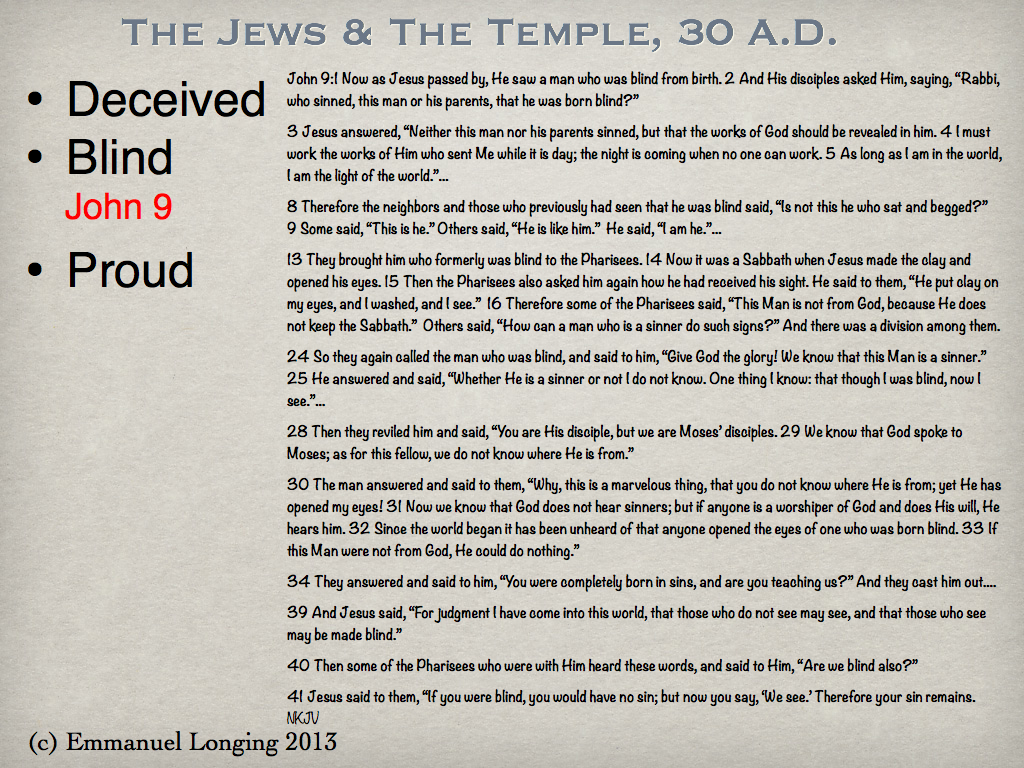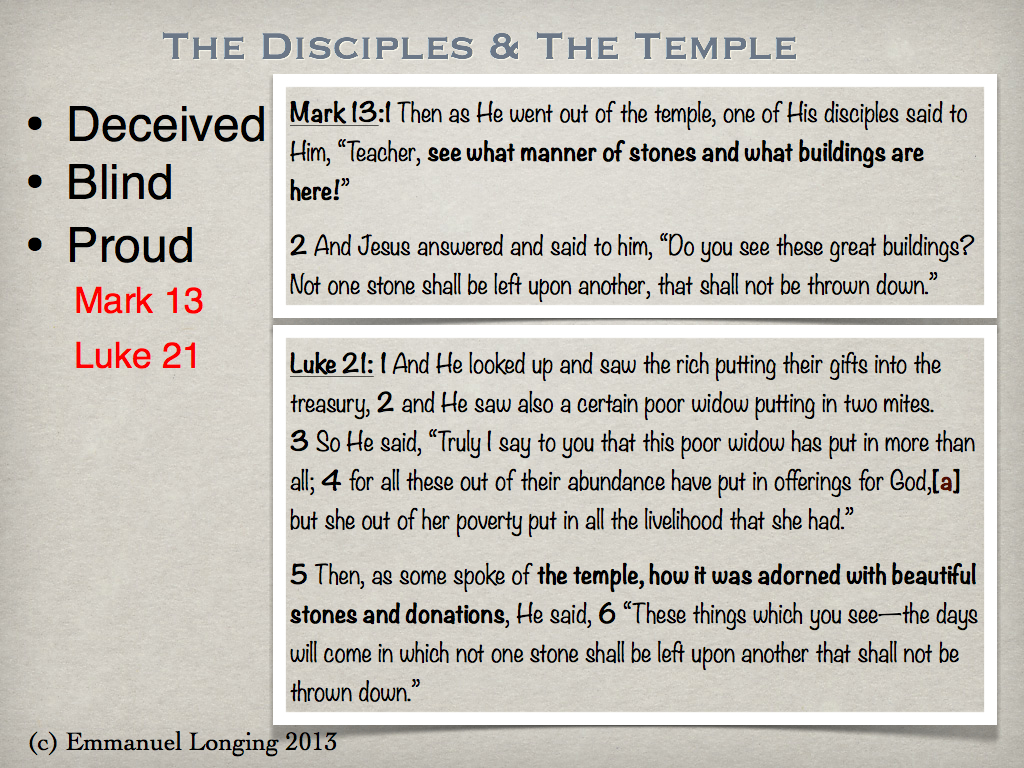Let us here consider what was the condition of the heart, mind, and eyes of the Jewish Leaders. In particular, we will note three important New Testament passages that illustrate their state of deception, blindness, and pride. First, let us see their deception, but in so doing we should keep in mind such state of deception is our natural state–both Jew and Gentile–apart and until God’s Spirit lifts the curtain of darkness and confusion that is our universal, natural condition: In the above passage, there is a dinner party with many guests and, in the custom of the day, including numerous non-dining observers. The story focuses on just three persons out of all the attendants: the host, a Pharisee named Simon (not the Simon later named Peter, the disciple of Jesus), Jesus Himself, the primary invited guest, and an unnamed woman as the third person in this dinner ‘trinity.’ This is a parable of great contrasts. The Pharisee and the woman are as opposite as can be. The venue is the Pharisee’s house, which was likely something quite impressive. The Pharisee is named (Simon). He is an initiator of the dinner, having invited Jesus. He obeys, formally, the strictest interpretation of the requirements of Old Testament Law.
In the above passage, there is a dinner party with many guests and, in the custom of the day, including numerous non-dining observers. The story focuses on just three persons out of all the attendants: the host, a Pharisee named Simon (not the Simon later named Peter, the disciple of Jesus), Jesus Himself, the primary invited guest, and an unnamed woman as the third person in this dinner ‘trinity.’ This is a parable of great contrasts. The Pharisee and the woman are as opposite as can be. The venue is the Pharisee’s house, which was likely something quite impressive. The Pharisee is named (Simon). He is an initiator of the dinner, having invited Jesus. He obeys, formally, the strictest interpretation of the requirements of Old Testament Law.
The woman, on the other hand, is the lowliest of the low. She is a social outcast as a prostitute. She is unnamed, and not a dinner guest. Simon the Pharisee clearly sees her as a sinner. But her heart is so low because of her life that she recognizes her condition as a sinner in need of Grace. She expresses this by the loving, humble affection displayed toward Jesus, who is her only hope of redemption.
Simon, seeing this ‘kind’ of woman, even in her act of kindness, touching Jesus’s feet concludes that Jesus cannot be a prophet. Because, Simon reasons, were He a prophet He would have known what kind of a woman she was and absolutely would not have permitted her close presence let along physical touch. So Simon concludes that Jesus is some kind of fake, that the woman is a grave sinner, and that he himself is in God’s favor, and a wise observer. But Simon is deeply deceived.
Jesus in giving Simon this parable gives us an insight into the heart of the woman, and into the heart of Simon. Yes there are two sinners present in this scene. But they are not Jesus and the woman. They are Simon and the woman. But the woman in deepest gratitude for her deliverance from the judgment due on her life is overwhelmed with loving gratitude. Simon, on the other hand, likely has some small measure of gratitude because in his deception he sees himself as either entirely good, or very close to that.
Now let us turn to an even deeper perceptual problem, namely that of blindness. Consider the below scene: In the above story we have contrasted a particular man, one born physically blind, with a category of men, Pharisees, who have a deeper kind of blindness. In a straightforward sequence of events, Jesus performs the miracle of giving sight to the blind, which of course illustrates and demonstrates his giving us the capacity ‘to see’ spiritual things while stuck in a fallen, material, space-time world.
In the above story we have contrasted a particular man, one born physically blind, with a category of men, Pharisees, who have a deeper kind of blindness. In a straightforward sequence of events, Jesus performs the miracle of giving sight to the blind, which of course illustrates and demonstrates his giving us the capacity ‘to see’ spiritual things while stuck in a fallen, material, space-time world.
What happens to the sight of the Pharisees? They stumble over an issue of their law, namely Sabbath-keeping. Jesus performed this ‘work’ of curing the blind man on a Saturday, a holy day of worship in which no “work” was to be done. Had Jesus performed this healing on any other day of the week, the Pharisees would have faced a conundrum, namely: this ‘man’ Jesus was able to perform true and just miracles of healing under “just” circumstances. But because this particular healing occurred on a Saturday, the Pharisees concluded that Jesus must be an evil-doer because He was not keeping the Old Testament Law.
What should have happened? The Pharisees should have ‘seen’ that the Sabbath Law was not given as a duty of sacrifice of men to God but as a blessing of God to men, a day of rest signifying trust and faith. Further that Jesus who demonstrates His power over all human impossibility was Someone much greater than the Law of the Sabbath. (In the ultimate irony, the principal teaching of Sabbath keeping was one’s cessation from self-effort, especially that self-effort we are all inclined to exert to establish our own personal, independent righteousness; so in judging Jesus, they were actually violating the Sabbath while believing they were righteous in upholding it!)
Finally, let us consider the effect of Pride: Again we have the distinction provided of two persons in the above parable: the self-righteous Pharisee, and the lowly humility of the hated publican (a tax collector who works on behalf of the hated Roman occupiers, and often corruptly in doing so). The Pharisee is focused on his own superiority to the publican. In a bizarrely twisted prayer that appears to show one good man who is thanking God, the Pharisee is proclaiming his own righteousness while standing in the very shadow of the Temple. The publican in contrast stands in complete humility before God, which causes him to have his head bowed and his feet planted afar off.
Again we have the distinction provided of two persons in the above parable: the self-righteous Pharisee, and the lowly humility of the hated publican (a tax collector who works on behalf of the hated Roman occupiers, and often corruptly in doing so). The Pharisee is focused on his own superiority to the publican. In a bizarrely twisted prayer that appears to show one good man who is thanking God, the Pharisee is proclaiming his own righteousness while standing in the very shadow of the Temple. The publican in contrast stands in complete humility before God, which causes him to have his head bowed and his feet planted afar off.
Lest we think such pride was only the plague of Pharisees, recall that Jesus’s own disciples argued among themselves as to which of them was the greatest, that Peter sought to correct Jesus (!) when He foretold His coming death, and even with regard to the very buildings and grounds on the Temple Mount that we have been considering here: As was discussed earlier, the promise of the Promised Land, together with the Presence of the Name of YHWH in the Temple were believed to be an impregnable guarantee of the Lord’s favor upon the people, and nation, of Israel. We began this study in Lamentations 3 written in the midst of the loss of both the Land and the Temple to the Babylonian captivity. Now at the time of Christ when He gave the above prophetic warning, it would have been unthinkable to consider that yet again there would be a judgment of utter ruin and exile, particularly when, as at the time of Christ, there was an established arrangement with the massively powerful Roman nation. Yet such exile and destruction occurred, as prophetically warned, in just a generation (ca. 40 years: the period from ca. 30 A.D. to the known date of 70 A.D. when Jerusalem was destroyed by the Roman army in putting down a Jewish rebellion).
As was discussed earlier, the promise of the Promised Land, together with the Presence of the Name of YHWH in the Temple were believed to be an impregnable guarantee of the Lord’s favor upon the people, and nation, of Israel. We began this study in Lamentations 3 written in the midst of the loss of both the Land and the Temple to the Babylonian captivity. Now at the time of Christ when He gave the above prophetic warning, it would have been unthinkable to consider that yet again there would be a judgment of utter ruin and exile, particularly when, as at the time of Christ, there was an established arrangement with the massively powerful Roman nation. Yet such exile and destruction occurred, as prophetically warned, in just a generation (ca. 40 years: the period from ca. 30 A.D. to the known date of 70 A.D. when Jerusalem was destroyed by the Roman army in putting down a Jewish rebellion).
Before we go back in time to the establishment of the First Temple, let us consider this destruction of the Second (Herod’s) Temple.